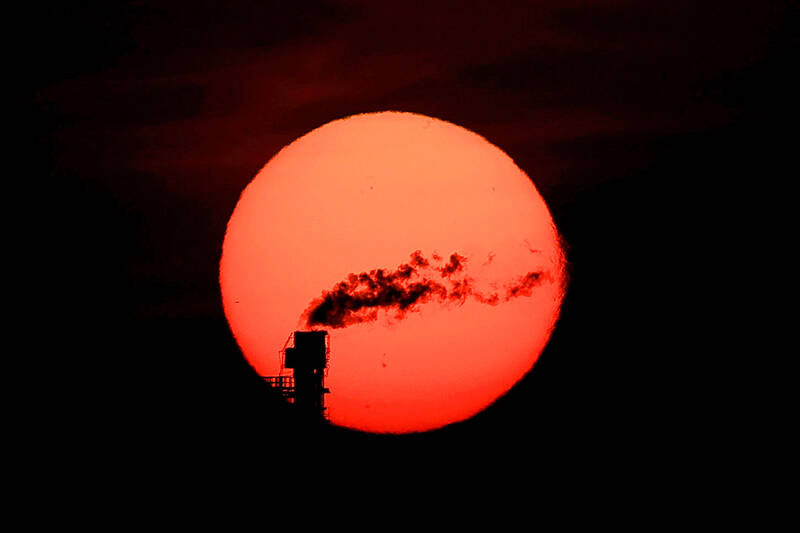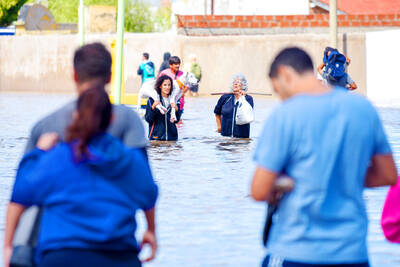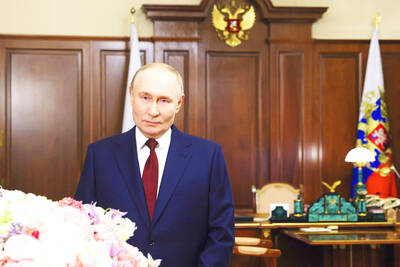Holding long-term global warming to 2°C — the fallback target of the Paris climate accord — is now “impossible,” according to a new analysis published by leading scientists.
Led by renowned climatologist James Hansen, the paper appears in the journal Environment: Science and Policy for Sustainable Development and concludes that Earth’s climate is more sensitive to rising greenhouse gas emissions than previously thought.
Compounding the crisis, Hansen and colleagues argued, is a recent decline in sunlight-blocking aerosol pollution from the shipping industry, which had been mitigating some of the warming.

Photo: Reuters
An ambitious climate change scenario outlined by the UN’s climate panel, which gives the planet a 50 percent chance of keeping warming under 2°C by the year 2100, “is an implausible scenario,” Hansen told a briefing on Tuesday.
“That scenario is now impossible,” said Hansen, formerly a top NASA climate scientist who famously announced to the US Congress in 1988 that global warming was underway.
“The 2°C target is dead,” he said.
Instead, he and coauthors argued, the amount of greenhouse gases already pumped into the atmosphere by burning fossil fuels meant increased warming is now guaranteed.
Temperatures would stay at or above 1.5°C in the coming years — devastating coral reefs and fueling more intense storms — before rising to about 2.0°C by 2045, they forecast.
They estimated polar ice melt and freshwater injection into the North Atlantic would trigger the shutdown of the Atlantic Meridional Overturning Circulation (AMOC) within the next 20 to 30 years.
The current brings warmth to various parts of the globe and also carries nutrients necessary to sustain ocean life.
Its end “will lock in major problems including sea level rise of several meters — thus, we describe AMOC shutdown as the ‘point of no return,’” the paper argued.
The world’s nations agreed during the landmark Paris climate accord of 2015 to try to hold end-of-century warming to 1.5°C above preindustrial levels.
Scientists identified the threshold as critical to preventing the breakdown of major ocean circulation systems, the abrupt thawing of boreal permafrost, and the collapse of tropical coral reefs.
The 1.5°C target has already been breached over the past two years, data from the EU’s climate monitoring system Copernicus showed, although the Paris agreement referred to a long-term trend over decades.
At 2°C, the impacts would be even greater, including irreversible loss to Earth’s ice sheets, mountain glaciers and snow, sea ice and permafrost.
The authors acknowledged the findings appeared grim, but argued that honesty is a necessary ingredient for change.
“Failure to be realistic in climate assessment and failure to call out the fecklessness of current policies to stem global warming is not helpful to young people,” they said.
“Today, with rising crises including global climate change, we have reached a point where we must address the problem of special interests,” they added, stressing they were “optimistic” for the future.

ANGER: A video shared online showed residents in a neighborhood confronting the national security minister, attempting to drag her toward floodwaters Argentina’s port city of Bahia Blanca has been “destroyed” after being pummeled by a year’s worth of rain in a matter of hours, killing 13 and driving hundreds from their homes, authorities said on Saturday. Two young girls — reportedly aged four and one — were missing after possibly being swept away by floodwaters in the wake of Friday’s storm. The deluge left hospital rooms underwater, turned neighborhoods into islands and cut electricity to swaths of the city. Argentine Minister of National Security Patricia Bullrich said Bahia Blanca was “destroyed.” The death toll rose to 13 on Saturday, up from 10 on Friday, authorities

Two daughters of an Argentine mountaineer who died on an icy peak 40 years ago have retrieved his backpack from the spot — finding camera film inside that allowed them a glimpse of some of his final experiences. Guillermo Vieiro was 44 when he died in 1985 — as did his climbing partner — while descending Argentina’s Tupungato lava dome, one of the highest peaks in the Americas. Last year, his backpack was spotted on a slope by mountaineer Gabriela Cavallaro, who examined it and contacted Vieiro’s daughters Guadalupe, 40, and Azul, 44. Last month, the three set out with four other guides

Local officials from Russia’s ruling party have caused controversy by presenting mothers of soldiers killed in Ukraine with gifts of meat grinders, an appliance widely used to describe Russia’s brutal tactics on the front line. The United Russia party in the northern Murmansk region posted photographs on social media showing officials smiling as they visited bereaved mothers with gifts of flowers and boxed meat grinders for International Women’s Day on Saturday, which is widely celebrated in Russia. The post included a message thanking the “dear moms” for their “strength of spirit and the love you put into bringing up your sons.” It

‘LIMITING MYSELF’: New Zealand’s foreign minister said that the omments by Phil Goff were ‘disappointing’ and made the diplomat’s position in the UK ‘untenable’ New Zealand’s most senior envoy to the UK has lost his job over remarks he made about US President Donald Trump at an event in London this week, New Zealand Minister of Foreign Affairs Winston Peters said yesterday. Phil Goff, who is New Zealand’s High Commissioner to the UK, made the comments at an event held by international affairs think tank Chatham House in London on Tuesday. Goff asked a question from the audience of the guest speaker, Finnish Minister of Foreign Affairs Elina Valtonen, in which he said he had been re-reading a famous speech by former British prime minister Winston